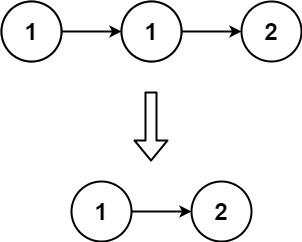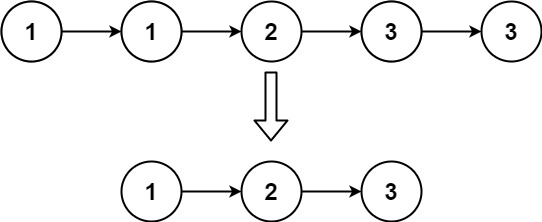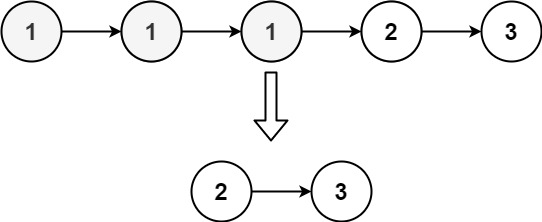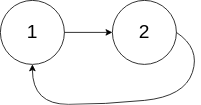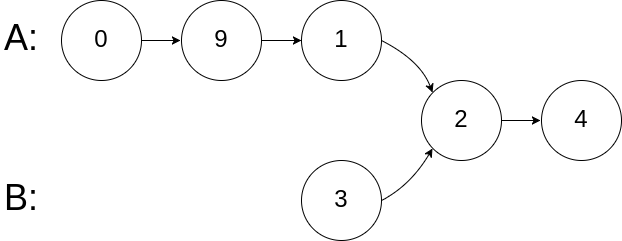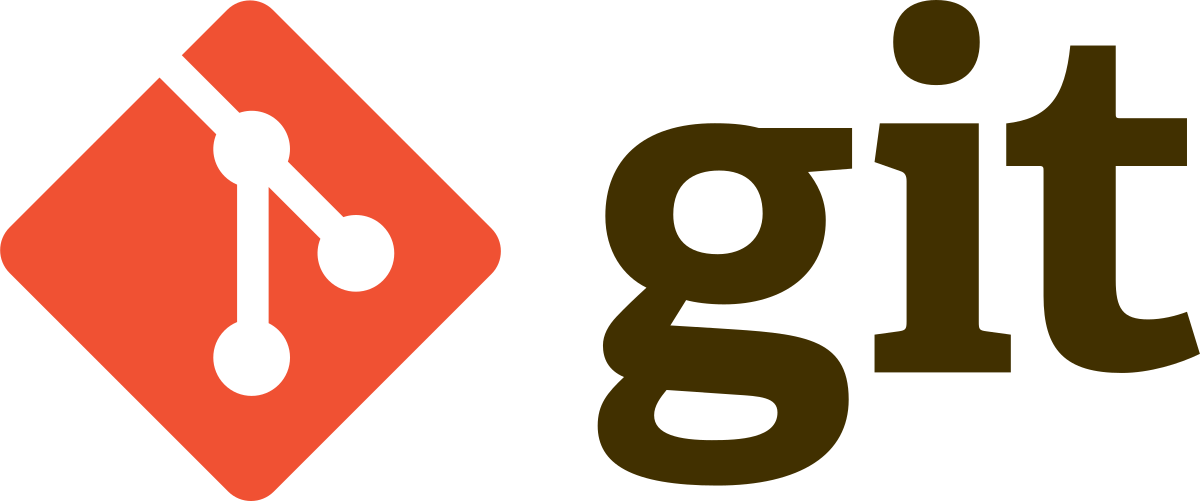6 从尾到头打印链表
输入一个链表的头节点,从尾到头反过来返回每个节点的值(用数组返回)。
示例 1:
输入:head = [1,3,2]
输出:[2,3,1]限制:
0 <= 链表长度 <= 10000题解
/*递归*/
/**
* Definition for singly-linked list.
* struct ListNode {
* int val;
* ListNode *next;
* ListNode(int x) : val(x), next(NULL) {}
* };
*/
class Solution {
public:
vector<int> reversePrint(ListNode* head) {
if (!head)
return {};
vector<int> arr = reversePrint(head->next);
arr.push_back(head->val);
return arr;
}
};
class Solution {
public:
vector<int> arr;
vector<int> reversePrint(ListNode* head) {
if (head)
{
if(head->next)
reversePrint(head->next);
arr.push_back(head->val);
}
return arr;
}
};
18 删除链表的节点
给定单向链表的头指针和一个要删除的节点的值,定义一个函数删除该节点。
返回删除后的链表的头节点。
注意:此题对比原题有改动
示例 1:
输入: head = [4,5,1,9], val = 5
输出: [4,1,9]
解释: 给定你链表中值为 5 的第二个节点,那么在调用了你的函数之后,该链表应变为 4 -> 1 -> 9.示例 2:
输入: head = [4,5,1,9], val = 1
输出: [4,5,9]
解释: 给定你链表中值为 1 的第三个节点,那么在调用了你的函数之后,该链表应变为 4 -> 5 -> 9.说明:
- 题目保证链表中节点的值互不相同
- 若使用 C 或 C++ 语言,你不需要 $free$ 或 $delete$ 被删除的节点
题解
/**
* Definition for singly-linked list.
* struct ListNode {
* int val;
* ListNode *next;
* ListNode(int x) : val(x), next(NULL) {}
* };
*/
class Solution {
public:
ListNode* deleteNode(ListNode* head, int val) {
if(head->val==val)return head->next;
ListNode *pre = head, *cur = head->next;
while(cur != NULL && cur->val != val)
{
pre = cur;
cur = cur->next;
}
if(cur != NULL)pre->next=cur->next;
return head;
}
};(83) 删除排序链表中的重复元素
给定一个已排序的链表的头 $head$ , 删除所有重复的元素,使每个元素只出现一次 。返回 已排序的链表 。
示例 1:
输入:head = [1,1,2]
输出:[1,2]示例 2:
输入:head = [1,1,2,3,3]
输出:[1,2,3]提示:
- 链表中节点数目在范围 $[0, 300]$ 内
- $-100 <= Node.val <= 100$
- 题目数据保证链表已经按升序 排列
题解
class Solution {
public:
ListNode* deleteDuplicates(ListNode* head) {
if(!head){
return head;
}
ListNode* cur = head;
while(cur->next){
if(cur->val == cur->next->val){
cur->next = cur->next->next;
}else{
cur=cur->next;
}
}
return head;
}
};(82)删除排序链表中的重复元素 II
给定一个已排序的链表的头 $head$ , 删除原始链表中所有重复数字的节点,只留下不同的数字 。返回 已排序的链表 。
示例 1:
输入:head = [1,2,3,3,4,4,5]
输出:[1,2,5]示例 2:
输入:head = [1,1,1,2,3]
输出:[2,3]提示:
- 链表中节点数目在范围 $[0, 300]$ 内
- $-100 <= Node.val <= 100$
- 题目数据保证链表已经按升序 排列
题解
class Solution {
public:
ListNode* deleteDuplicates(ListNode* head) {
if(!head||!head->next)return head;
ListNode *preHead=new ListNode(0);
preHead->next=head;
ListNode *pre=preHead;
ListNode *cur=head;
while(cur)
{
while(cur->next && cur->val==cur->next->val)
{
cur=cur->next;//跳过当前重复节点
}
if(pre->next==cur)
{
pre=pre->next;//pre无重复节点,pre后移
}
else
{//pre不移动,指向已经遍历完的链表结尾
pre->next=cur->next;
}
cur = cur->next;
}
return preHead->next;
}
};22 链表中倒数第k个节点
输入一个链表,输出该链表中倒数第k个节点。为了符合大多数人的习惯,本题从1开始计数,即链表的尾节点是倒数第1个节点。
例如,一个链表有 $6$ 个节点,从头节点开始,它们的值依次是 $1、2、3、4、5、6$。这个链表的倒数第 $3$ 个节点是值为 $4$ 的节点。
示例:
给定一个链表: 1->2->3->4->5, 和 k = 2.
返回链表 4->5.题解
/**
* Definition for singly-linked list.
* struct ListNode {
* int val;
* ListNode *next;
* ListNode(int x) : val(x), next(NULL) {}
* };
*/
class Solution {
public:
ListNode* getKthFromEnd(ListNode* head, int k) {
ListNode* cur = head, *pre=head;
for(int i=0;i<k;i++)
{
cur= cur->next;
}
while(cur!=NULL)
{
pre=pre->next;
cur=cur->next;
}
return pre;
}
};Z22(142) 链表中环的入口节点
定一个链表,返回链表开始入环的第一个节点。 从链表的头节点开始沿着 $next$ 指针进入环的第一个节点为环的入口节点。如果链表无环,则返回 $null$。
为了表示给定链表中的环,我们使用整数 $pos$ 来表示链表尾连接到链表中的位置(索引从 0 开始)。 如果 $pos$ 是 $-1$,则在该链表中没有环。注意,$pos$ 仅仅是用于标识环的情况,并不会作为参数传递到函数中。
说明:不允许修改给定的链表。
示例 1:
输入:head = [3,2,0,-4], pos = 1
输出:返回索引为 1 的链表节点
解释:链表中有一个环,其尾部连接到第二个节点。示例 2:
输入:head = [1,2], pos = 0
输出:返回索引为 0 的链表节点
解释:链表中有一个环,其尾部连接到第一个节点。示例 3:
输入:head = [1], pos = -1
输出:返回 null
解释:链表中没有环。提示:
- 链表中节点的数目范围在范围 $[0, 104]$ 内
- $-105 <= Node.val <= 105$
- $pos$ 的值为 $-1$ 或者链表中的一个有效索引
进阶:是否可以使用 $O(1)$ 空间解决此题?
题解
/*
* @lc app=leetcode.cn id=142 lang=cpp
*
* [142] 环形链表 II
*/
// @lc code=start
/**
* Definition for singly-linked list.
* struct ListNode {
* int val;
* ListNode *next;
* ListNode(int x) : val(x), next(NULL) {}
* };
*/
class Solution {
public:
ListNode *detectCycle(ListNode *head) {
ListNode *fast = head, *slow = head;
while(true)
{
if(fast == NULL || fast->next == NULL) return NULL;
fast = fast->next->next;
slow = slow->next;
if(fast==slow)break;
}
fast = head;
while(slow != fast)
{
slow = slow->next;
fast = fast->next;
}
return fast;
}
};
// @lc code=end
24 环形链表
给你单链表的头节点 $head$ ,请你反转链表,并返回反转后的链表。
示例 1:
输入:head = [1,2,3,4,5]
输出:[5,4,3,2,1]示例 2:
输入:head = [1,2]
输出:[2,1]示例 3:
输入:head = []
输出:[]提示:
- 链表中节点的数目范围是 $[0, 5000]$
- $-5000 <= Node.val <= 5000$
题解
/*递归*/
class Solution {
public:
ListNode* reverseList(ListNode* head) {
return recur(head, nullptr);
}
private:
ListNode* recur(ListNode* cur, ListNode* pre){
if(cur==nullptr)return pre;//终止条件
ListNode* res = recur(cur->next, cur);//后继节点递归
cur->next = pre;//修改节点引用指向
return res;//返回反转链表的头节点
}
};
/*双指针迭代*/
/**
* Definition for singly-linked list.
* struct ListNode {
* int val;
* ListNode *next;
* ListNode(int x) : val(x), next(NULL) {}
* };
*/
class Solution {
public:
ListNode* reverseList(ListNode* head) {
ListNode *cur = head, *pre = NULL;
while(cur!=NULL){
ListNode* tmp = cur->next; //暂存后继节点cur.next
cur->next = pre; //修改next引用指向
pre = cur;//pre暂存cur
cur = tmp;//cur访问下一节点
}
return pre;
}
};25(21) 合并两个排序的链表
输入两个递增排序的链表,合并这两个链表并使新链表中的节点仍然是递增排序的。
示例1:
输入:1->2->4, 1->3->4
输出:1->1->2->3->4->4限制:
0 <= 链表长度 <= 1000题解
/*递归025*/
/**
* Definition for singly-linked list.
* struct ListNode {
* int val;
* ListNode *next;
* ListNode(int x) : val(x), next(NULL) {}
* };
*/
class Solution {
public:
ListNode* mergeTwoLists(ListNode* l1, ListNode* l2) {
if(l1==NULL)return l2;
if(l2==NULL)return l1;
if(l1->val<=l2->val){
l1->next = mergeTwoLists(l1->next, l2);
return l1;
}else{
l2->next = mergeTwoLists(l1, l2->next);
return l2;
}
}
};
/*伪头节点021*/
class Solution {
public:
ListNode* mergeTwoLists(ListNode* list1, ListNode* list2) {
ListNode* dum =new ListNode(0), *cur = dum;
while(list1 != NULL && list2 != NULL)
{
if(list1->val < list2->val)
{
cur->next = list1;
list1 = list1->next;
}
else
{
cur->next = list2;
list2 = list2->next;
}
cur = cur->next;
}
cur->next = list1 != NULL ? list1 : list2;
return dum->next;
}
};35(138) 复杂链表的复制
请实现 $copyRandomList$ 函数,复制一个复杂链表。在复杂链表中,每个节点除了有一个 $next$ 指针指向下一个节点,还有一个 $random$ 指针指向链表中的任意节点或者 $null$。
示例 1:
输入:head = [[7,null],[13,0],[11,4],[10,2],[1,0]]
输出:[[7,null],[13,0],[11,4],[10,2],[1,0]]示例 2:
输入:head = [[1,1],[2,1]]
输出:[[1,1],[2,1]]示例 3:
输入:head = [[3,null],[3,0],[3,null]]
输出:[[3,null],[3,0],[3,null]]示例 4:
输入:head = []
输出:[]
解释:给定的链表为空(空指针),因此返回 null。提示:
- $-10000 <= Node.val <= 10000$
- $Node.random$ 为空(null)或指向链表中的节点。
- 节点数目不超过 1000 。
题解
/*035*/
/*
// Definition for a Node.
class Node {
public:
int val;
Node* next;
Node* random;
Node(int _val) {
val = _val;
next = NULL;
random = NULL;
}
};
*/
class Solution {
public:
Node* copyRandomList(Node* head) {
if(head==NULL)return NULL;
Node* cur = head;
unordered_map<Node*, Node*>map;
//复制节点(映射)
while(cur!= NULL)
{
map[cur] = new Node(cur->val);
cur = cur->next;
}
cur = head;
//构建新链表的next及random指向
while(cur!=NULL)
{
map[cur]->next = map[cur->next];
map[cur]->random = map[cur->random];
cur = cur->next;
}
return map[head];
}
};
/*
* @lc app=leetcode.cn id=138 lang=cpp
*
* [138] 复制带随机指针的链表
*/
// @lc code=start
/*
// Definition for a Node.
class Node {
public:
int val;
Node* next;
Node* random;
Node(int _val) {
val = _val;
next = NULL;
random = NULL;
}
};
*/
class Solution {
public:
Node* copyRandomList(Node* head) {
if(head == nullptr)return nullptr;
Node* cur= head;
//复制各自节点,构建拼接链表
while(cur!=nullptr)
{
Node* tmp = new Node(cur->val);
tmp->next = cur->next;
cur->next = tmp;
cur = tmp->next;
}
//构建各自新节点的random指向
cur = head;
while(cur!=nullptr)
{
if(cur->random != nullptr)
{
cur->next->random= cur->random->next;
}
cur= cur->next->next;
}
//拆分链表
cur= head->next;
Node* pre = head, *res = head->next;
while(cur->next != nullptr)
{
pre->next = pre->next->next;
cur->next = cur->next->next;
pre = pre->next;
cur = cur->next;
}
pre->next = nullptr;
return res;
}
};
// @lc code=end
52(160) 两个链表的第一个公共节点
输入两个链表,找出它们的第一个公共节点。
如下面的两个链表:
在节点 c1 开始相交。
示例 1:
输入:intersectVal = 8, listA = [4,1,8,4,5], listB = [5,0,1,8,4,5], skipA = 2, skipB = 3
输出:Reference of the node with value = 8
输入解释:相交节点的值为 8 (注意,如果两个列表相交则不能为 0)。从各自的表头开始算起,链表 A 为 [4,1,8,4,5],链表 B 为 [5,0,1,8,4,5]。在 A 中,相交节点前有 2 个节点;在 B 中,相交节点前有 3 个节点。示例 2:
输入:intersectVal = 2, listA = [0,9,1,2,4], listB = [3,2,4], skipA = 3, skipB = 1
输出:Reference of the node with value = 2
输入解释:相交节点的值为 2 (注意,如果两个列表相交则不能为 0)。从各自的表头开始算起,链表 A 为 [0,9,1,2,4],链表 B 为 [3,2,4]。在 A 中,相交节点前有 3 个节点;在 B 中,相交节点前有 1 个节点。示例 3:
输入:intersectVal = 0, listA = [2,6,4], listB = [1,5], skipA = 3, skipB = 2
输出:null
输入解释:从各自的表头开始算起,链表 A 为 [2,6,4],链表 B 为 [1,5]。由于这两个链表不相交,所以 intersectVal 必须为 0,而 skipA 和 skipB 可以是任意值。
解释:这两个链表不相交,因此返回 null。注意:
- 如果两个链表没有交点,返回 $null$.
- 在返回结果后,两个链表仍须保持原有的结构。
- 可假定整个链表结构中没有循环。
- 程序尽量满足 O(n) 时间复杂度,且仅用 O(1) 内存
题解
/*052*/
/*160*/
class Solution {
public:
ListNode *getIntersectionNode(ListNode *headA, ListNode *headB) {
ListNode *A = headA, *B = headB;
while(A!=B){
A = A != NULL ? A->next : headB;
B = B != NULL ? B->next : headA;
}
return A;
}
};
